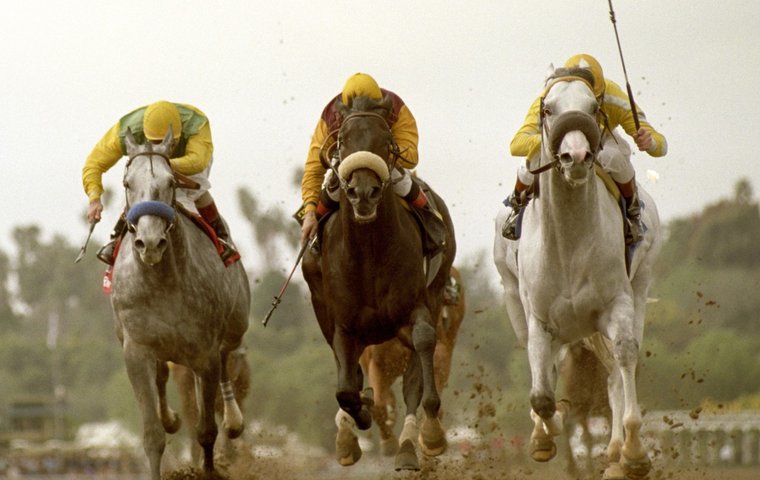
With the exception of Alydar, no three-year-old ever ran harder in all three legs of the Triple Crown without winning, says Jay Hovdey. Don’t miss the latest instalment of his must-read monthly series
They called him ‘Freebie’, and why not? Such a nickname connotes a scamp, a mischief-maker, an individual who has trouble taking himself seriously. The name on his papers read Free House – inspired by a tour of English taverns by his owners – and if there was a more animated, crowd-pleasing Thoroughbred of the late 1990s … never mind. There wasn’t.
Over parts of four seasons, pitted against a collection of world-class opponents, there remains to this day the picture of Free House, his white coat mottled gray, barreling along in some of the nation’s best races without a care in the world.
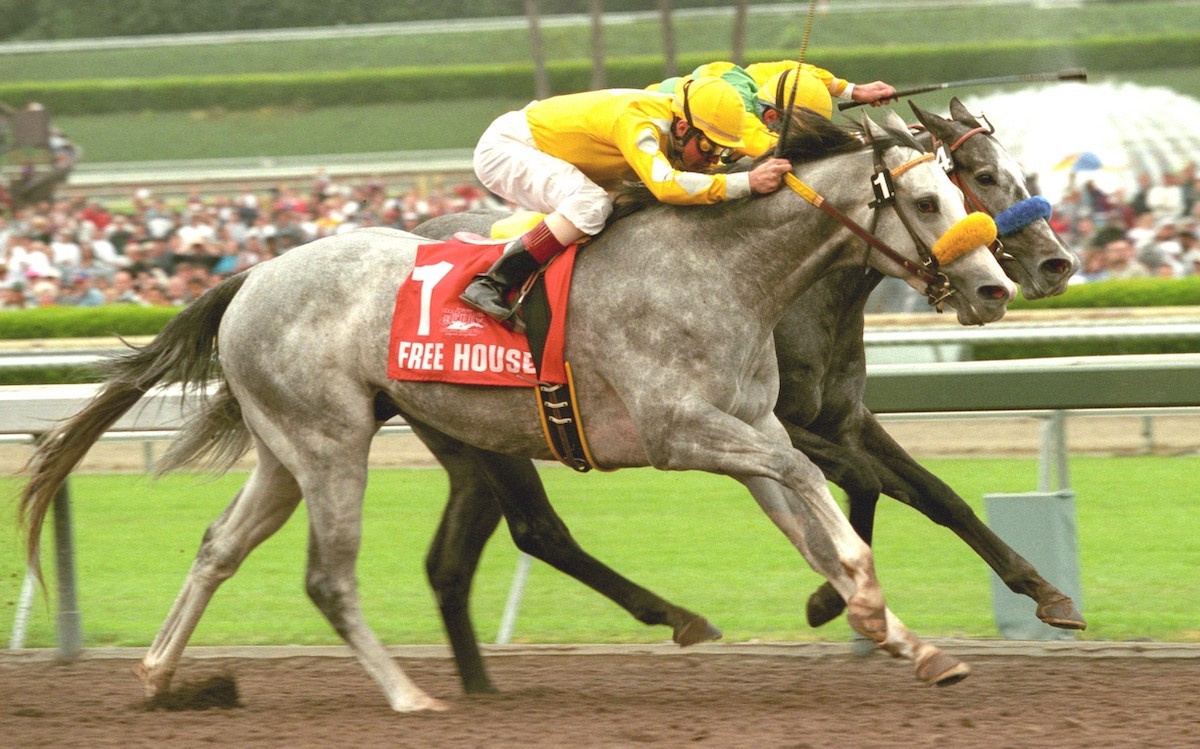 As a young horse he would cavort, duck, and dive. As he aged he delighted in winning or losing by inches – it was all about the chase – then at last, in maturity, he seemed to decide that more was expected, so he performed accordingly. Then he’d wink in the winner’s circle, as if pretending to be an adult was the biggest lark of all.
As a young horse he would cavort, duck, and dive. As he aged he delighted in winning or losing by inches – it was all about the chase – then at last, in maturity, he seemed to decide that more was expected, so he performed accordingly. Then he’d wink in the winner’s circle, as if pretending to be an adult was the biggest lark of all.
Those eyes, too, the irises white-rimmed and slightly crazed, if seen on a sullen teen would raise alarms. For Free House, though, his countenance was part of the charm. This reporter never paid a visit to the stables of Santa Anita, Hollywood Park, or Del Mar without a stop by the stall of Free House, quietly waiting for a snack or a stroll in the sun. He was a four-legged vitamin for the weary soul.
Halcyon spring
The US Triple Crown season is when Free House comes to mind for many. With the exception of Alydar, no three-year-old ever ran harder in all three jewels without winning than Free House, during that halcyon spring of 1997.
He was third after taking Silver Charm and the field deep into the stretch of the Kentucky Derby before. He was second by a bob of Silver Charm’s head in a four-horse Preakness finish for the ages. Then he was third in the Belmont Stakes on the day Silver Charm was thwarted by Touch Gold.
“Free House cost me the Triple Crown,” insists Gary Stevens, offering consummate respect. “I was convinced he was the one I had to beat. When we finally got past Free House in that last sixteenth, we never saw Touch Gold come along to catch us.”
Free House and Silver Charm stood as the two towering members of a 1994 North American foal crop that also featured Awesome Again, Captain Bodgit, Tale Of The Cat, Pulpit, and Deputy Commander, as well as Touch Gold. Of that deep and accomplished group, only two horses won graded stakes at two, three, four, and five: Free House and Silver Charm.
And while Silver Charm won two legs of the Triple Crown and the Dubai World Cup, Free House was never far behind. In fact, when asked to cite the Free House race that has stayed with him longest, trainer Juan ‘Paco’ Gonzalez takes very little time to decide.
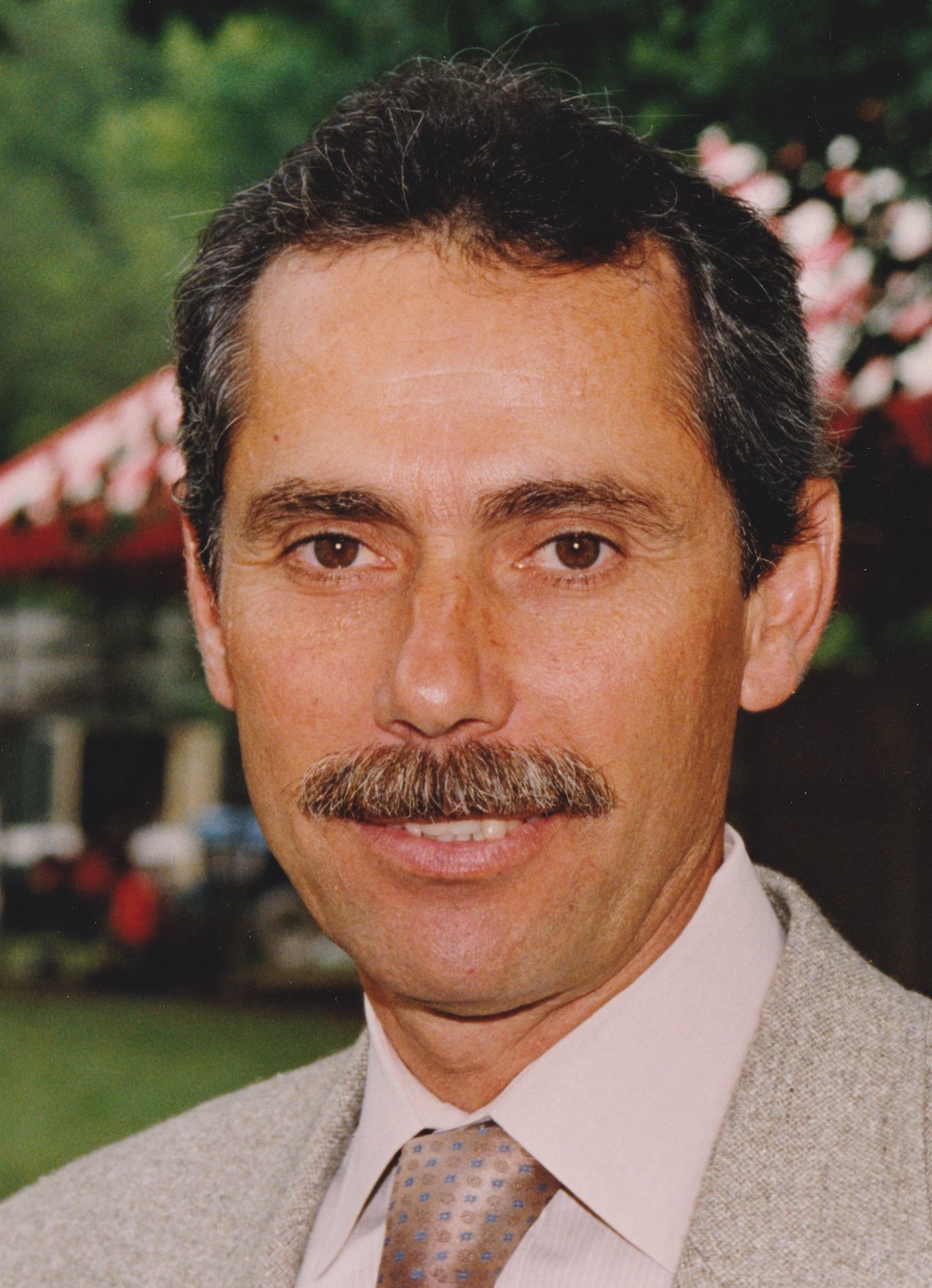 ‘He gave us everything’
‘He gave us everything’
“The Preakness,” Gonzalez will say. “I know it was a hard loss, but he ran so hard that day. He gave us everything.”
The story of Free House is deeply entwined with that of Gonzalez, for there were precious few hours in the day that the two of them were separated by more than a few yards of shed row real estate.
Gonzalez is a native of Yahualica, a town of some 57,000 today in the northern reaches of the Mexican state of Jalisco. The state capital, Guadalajara, is about 120 kilometers to the south. He was a young teen when his two older brothers, Miguel and Salvador, ventured to north of the border to pursue careers as jockeys. Paco followed in 1964 and went to work at Santa Anita as an exercise rider for Joe Manzi, a Charlie Whittingham disciple who had gone out on his own a few years earlier.
In 1968, Gonzalez had a front-row seat for his brother’s greatest victory. Going by his mother’s family name, Miguel Yanez won the Santa Anita Handicap aboard Mr. Right on a stormy March afternoon. Above the din of nearly 50,000 fans in the house could be heard the frantic supplications of Miguel’s younger brother.
“I was on the second floor of the grandstand when he went by and took the lead,” Gonzalez recalled. “I was yelling, ‘Go Miguel! Go Miguel!’ and then I hear the announcer, Joe Hernandez. ‘Here comes Jungle Road!’ I start running down the grandstand yelling, ‘No, no! Go, Miguel, go!’”
Yanez and Mr. Right won comfortably, and the Gonzalez family celebrated. Paco went on to be an integral part of a successful Manzi stable that included Kentucky Oaks winner Fran’s Valentine and Del Mar Derby winner Tanks Brigade, among many others.
The barn hit its highpoint in 1982 with the campaign of Roving Boy, the two-year-old Eclipse champion, and Gonzalez was his regular morning rider. However, what should have been a joyous chapter in the Gonzalez timeline ended sadly when Roving Boy came out of a work in early 1983 with a sore shin, then tragically when the son of Olden Times suffered a fatal injury in his comeback race at Santa Anita later that year.
By then, Gonzalez was as close to an assistant trainer as you can get, basically running the barn whenever Manzi had business out of town, and the most perceptive of their clients took notice. Among them were John Toffan, a Canadian entrepreneur in oil and minerals, and his partner Trudy McCaffery, a public relations executive.
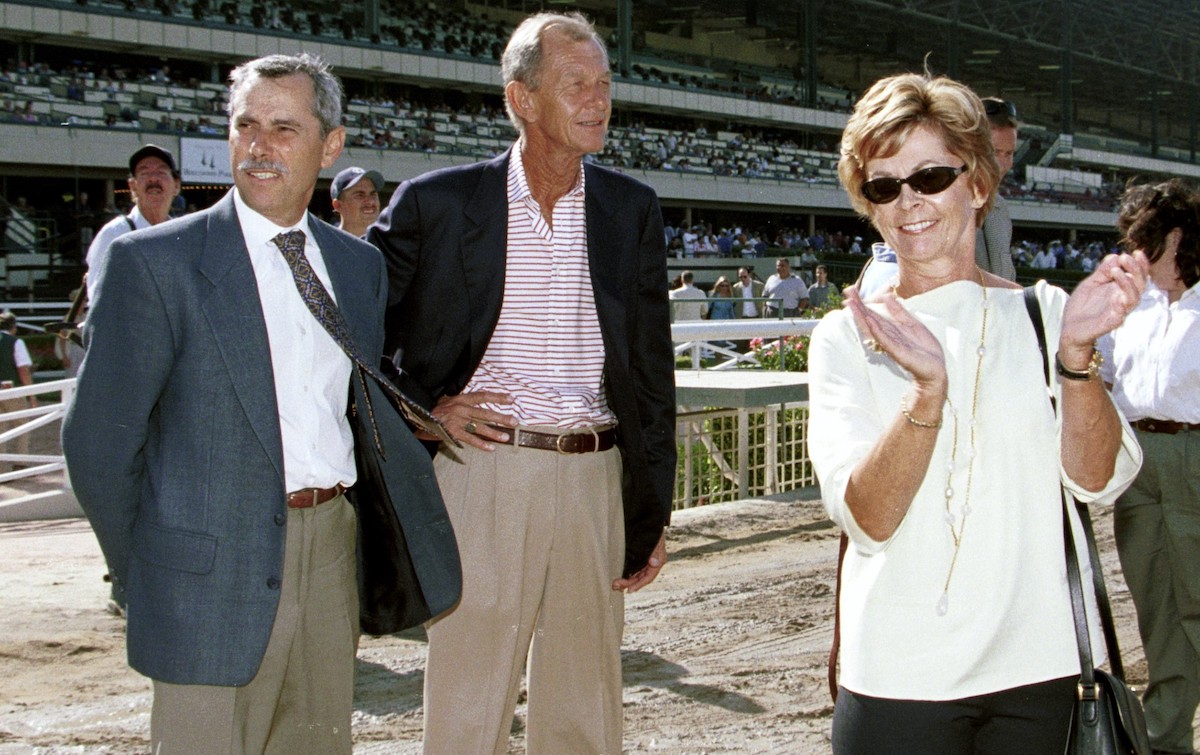 Private trainer
Private trainer
When Manzi died of a heart attack in April 1989, just shy of his 54th birthday, his wife Sandra turned to Gonzalez to keep the stable afloat. Soon, however, clients began to drift away, but Toffan and McCaffery knew a good thing when they saw it. Commencing in 1990, Gonzalez accepted their offer of a job as private trainer.
Put a bright golden ring around the Barrett’s sale of two-year-olds in March 1990. With Gonzalez at their side, Toffan and McCaffery went about the work of populating a racing stable. At the sale, held at the Barrett’s pavilion on the LA County Fairgrounds in Pomona, Toffan spent $35,000 on a colt by Never Tabled and $40,000 on a filly by Vigors. The colt was named Smokester, the filly Fountain Lake.
Their sires were of significance, especially Vigors, who had roared through the winter of 1978 at Santa Anita like nothing seen before or since. At the time, Vigors already was proven to be a solid stakes horse on turf in a deeply competitive Southern California climate.
After turning five, he was tried on the main track by trainer Larry Sterling to shocking results. Lagging far behind the typically swift pacesetters, the near-white son of Grey Dawn II would charge through his final three furlongs like a creature possessed, winning the San Marcos Handicap, the San Antonio Stakes, and the Santa Anita Handicap over increasingly difficult opposition.
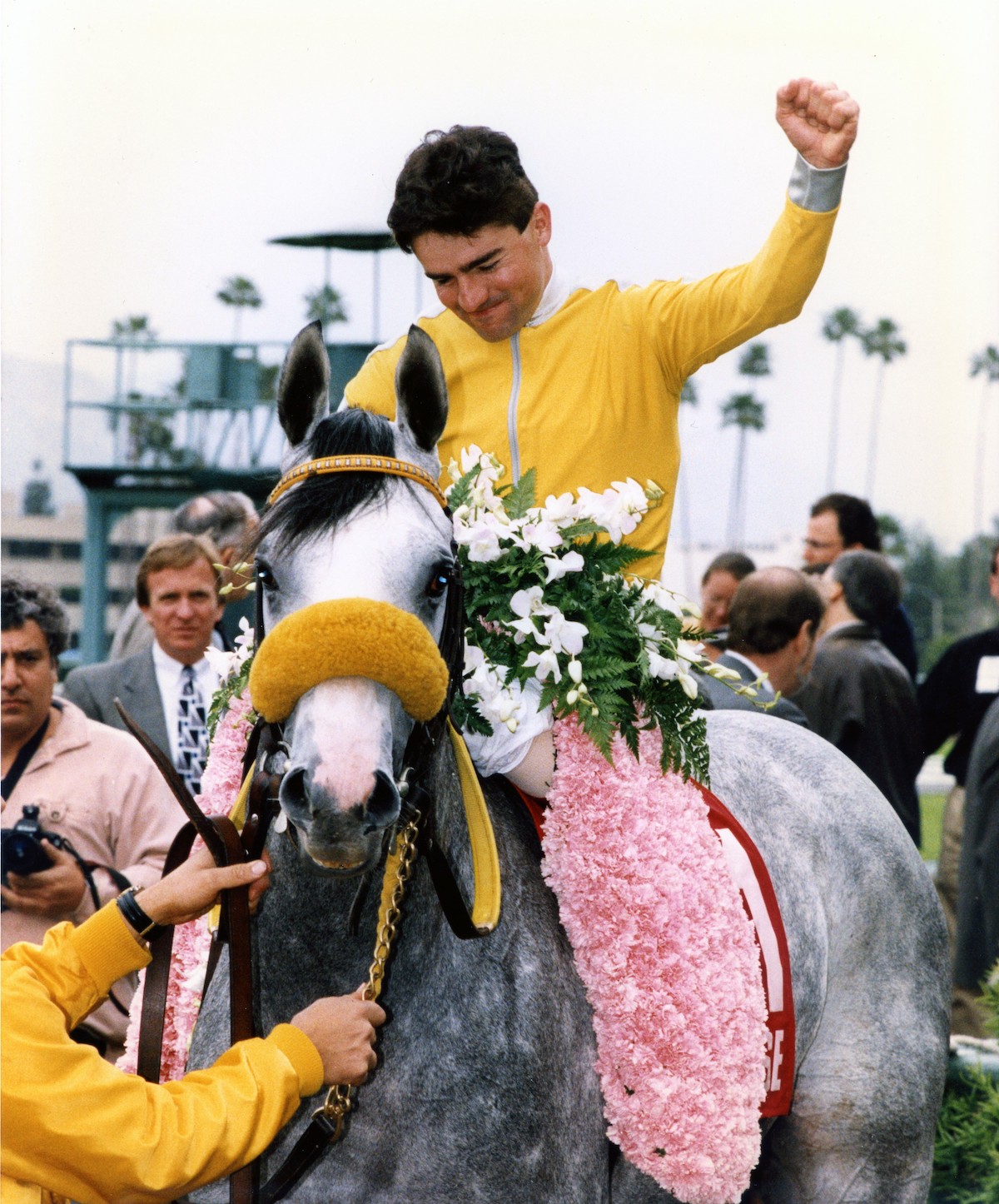 As a result, his popularity soared. Vigors was dubbed the ‘White Tornado’ by the media, an improvement over the cleaning product from which the nickname was derived. His owner-breeder William R. Hawn also was part-owner of the NFL’s Dallas Cowboys, winners of Super Bowl XII on Jan. 18, 1978. Two months later, after Vigors won the Santa Anita Handicap, Hawn declared: “This is my greatest thrill in sports.”
As a result, his popularity soared. Vigors was dubbed the ‘White Tornado’ by the media, an improvement over the cleaning product from which the nickname was derived. His owner-breeder William R. Hawn also was part-owner of the NFL’s Dallas Cowboys, winners of Super Bowl XII on Jan. 18, 1978. Two months later, after Vigors won the Santa Anita Handicap, Hawn declared: “This is my greatest thrill in sports.”
Compared to Vigors, Never Tabled was a bright flash in the pan. His breeding was impeccable – by Never Bend out of a Round Table mare – but early injuries delayed his racing debut until he was five. Trained by Richard Mandella, a lad of 31 at the time, Never Tabled won three of his first four starts, including the Triple Bend Handicap at Hollywood Park, before coming out of his fifth start with a career-ending malady.
Never Tabled went on to become one of the west’s most popular stallions, sending forth 11 crops of tough, durable Thoroughbreds who gave their people full value. In contrast to the stallion’s brief career, a remarkable 47 of Never Tabled’s offspring made 40 or more starts.
Smokester, however, was not one of them, making only four starts for Gonzalez spread over 10 months of 1991.
“My brother Sal picked him out at the sale,” Gonzalez said. “He was a beautiful horse, almost black, big blaze, white on both legs behind. He was also the meanest horse I’d ever been around. We couldn’t find a groom to handle him. Sal and I had to do it. One time he cornered me in the stall at Del Mar. He kicked and missed me, but he took out a big piece of the adobe brick wall.”
Gonzalez noted that a chronic problem with a navicular bone compromised Smokester’s racing career. Still, he had the look of a stallion, if not necessarily the pedigree. His dam was Small World, an undistinguished mare by Transworld, hero the 1977 Irish St. Leger in those bygones days when only three-year-olds were allowed.
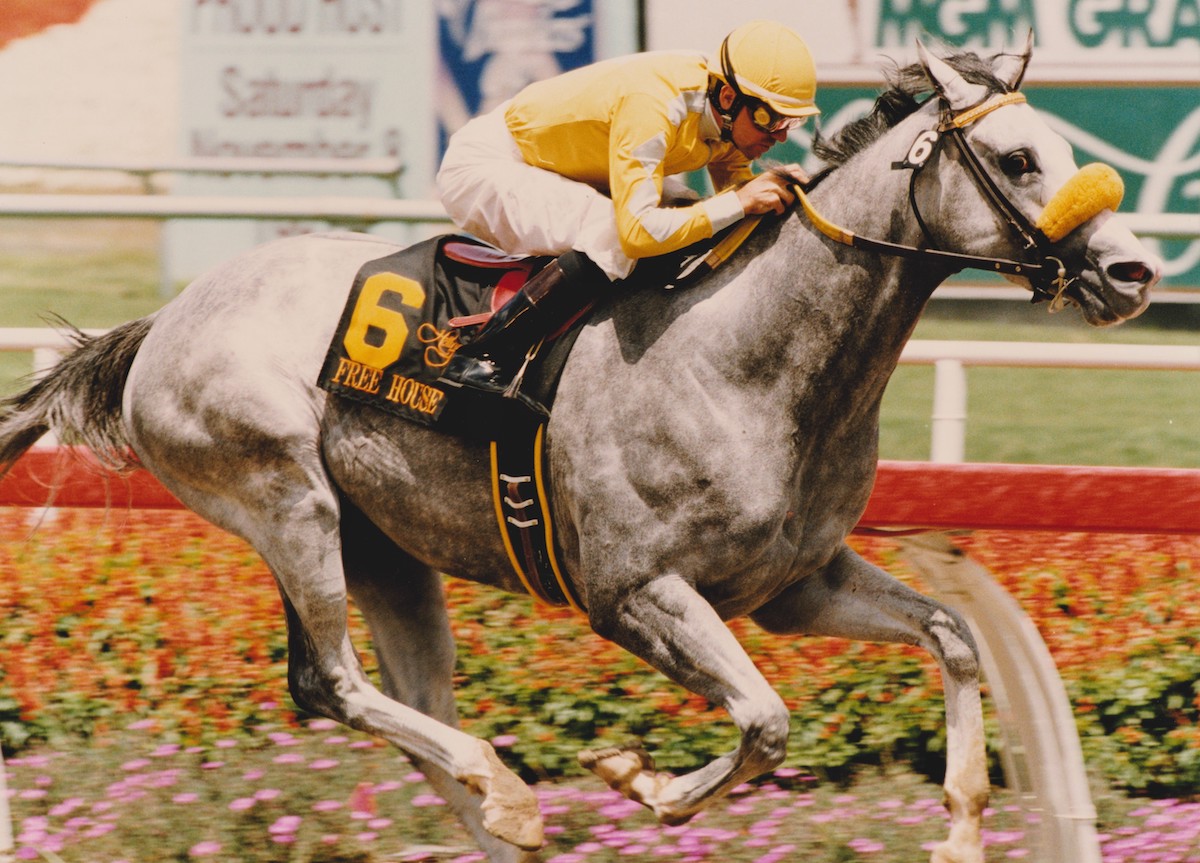 Small World’s granddam was Lawdy Claudy, winner of the 1958 Fashion Stakes at Belmont Park for Hall of Famer Tommy Kelly. Past that, it takes some digging before arriving at distant relatives like Carter Handicap winner Caterwaul and Alabama Stakes winner Running Water.
Small World’s granddam was Lawdy Claudy, winner of the 1958 Fashion Stakes at Belmont Park for Hall of Famer Tommy Kelly. Past that, it takes some digging before arriving at distant relatives like Carter Handicap winner Caterwaul and Alabama Stakes winner Running Water.
Both Smokester and Fountain Lake were new to the mating game when they were introduced in 1993. Gonzalez recalls her as a sweet, kind filly who won a maiden race, then was sent to Northern California to win a minor stakes event at a county fair meeting.
The best thing that could be said about Fountain Lake’s female family was a long, direct line to the landmark mare Alcibiades, the 1930 Kentucky Oaks winner who spawned a dynasty that included Alabama winner Salamina, Demoiselle Stakes winner Lithe, and Menow, sire of dual classic winner Capot and Horse of the Year Tom Fool.
Very few takers
Smokester stood that first season for a $500 fee and got very few takers. When his first crop of nine named foals came up with not only Free House, but also the $700,000-plus winner Bagshot, his career as a stallion was assured.
While at Cardiff Stud in central California, Smokester was commencing his 13th season at stud in 2005 when he collapsed and died in the act of breeding, leaving a single named foal of 2006.
By then, however, Smokester’s limited legacy was set in stone because of Free House. Among the all-time greats produced in the Golden State, Freebie is mentioned in the same conversation with Best Pal, Ancient Title, Lava Man, and Bertrando, with only Tiznow, Snow Chief, California Chrome, and Swaps hovering above.
Unlike his sire, Free House was a mellow soul, everyone’s favorite kid on the block. Even at the most pressure-packed moments of his career, his fans felt welcomed by the accommodating nature of the Toffan-McCaffery operation, while Gonzalez, though a very private, low-key caretaker, was genially transparent about his handling of a stable that included not only Free House, but such stakes class performers as A.P. Assay, Elaborate, Hollycombe and Bosque Redondo.
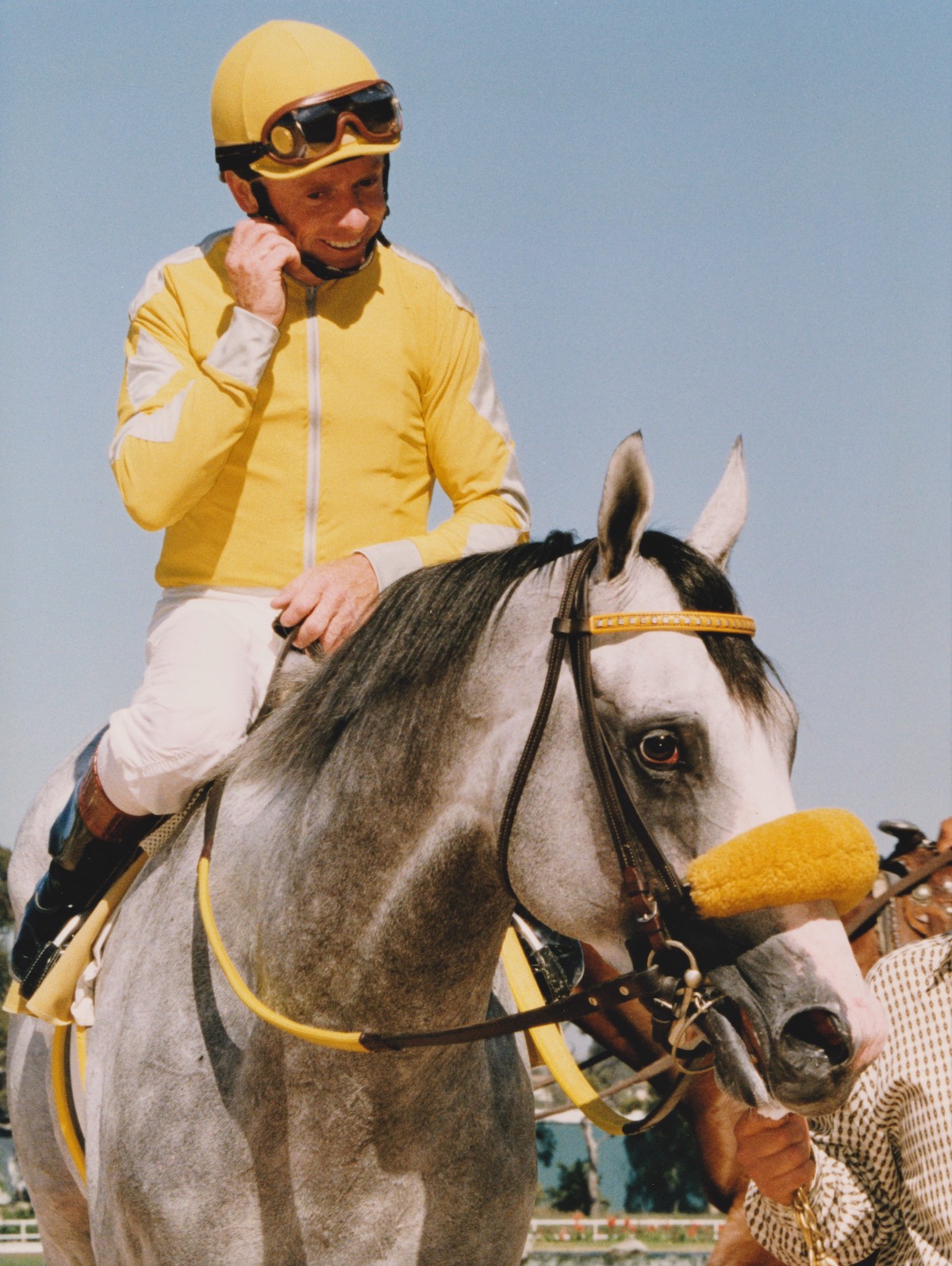 There were occasions, however, when the access got out of hand. “I was in my Hollywood Park office at about 2:30, waiting to take Free House out into the sunshine, when I heard something at his stall, right outside my door,” Gonzalez said. “A guy was standing there, looking at the horse. I never seen him before.”
There were occasions, however, when the access got out of hand. “I was in my Hollywood Park office at about 2:30, waiting to take Free House out into the sunshine, when I heard something at his stall, right outside my door,” Gonzalez said. “A guy was standing there, looking at the horse. I never seen him before.”
Turns out the fellow simply talked his way through the stable gate and got directions to the Gonzalez barn. “I asked the guys at the gate why they let him in,” Gonzalez said, still a little floored by the incident years later. “They said, ‘Well, he said he was a big Free House fan.’”
In the end, the gatecrasher was lucky Free House was the kind of creature who never met a stranger. “Because he was a healthy horse, he was a very happy horse, too,” Gonzalez said. “Chris McCarron would tell me that he never knew a horse who was so eager to go to the track. He loved to train.”
In fact, Free House was in almost non-stop training for most of his four seasons, with the notable exception coming after a rare sub-par showing in the 1997 Super Derby, when his race was compromised by exercise induced pulmonary haemorrhage, or bleeding. Gonzalez took him home to California and gave him a brief rest, then put him back into training.
‘Something not quite right’
“Watching him gallop, he wasn’t moving the same way,” Gonzalez said. “We did x-rays and they didn’t find anything. So I sent him for a nuclear scan, and there was something in the radius, the big bone above the knee. No fracture, but something not quite right.”
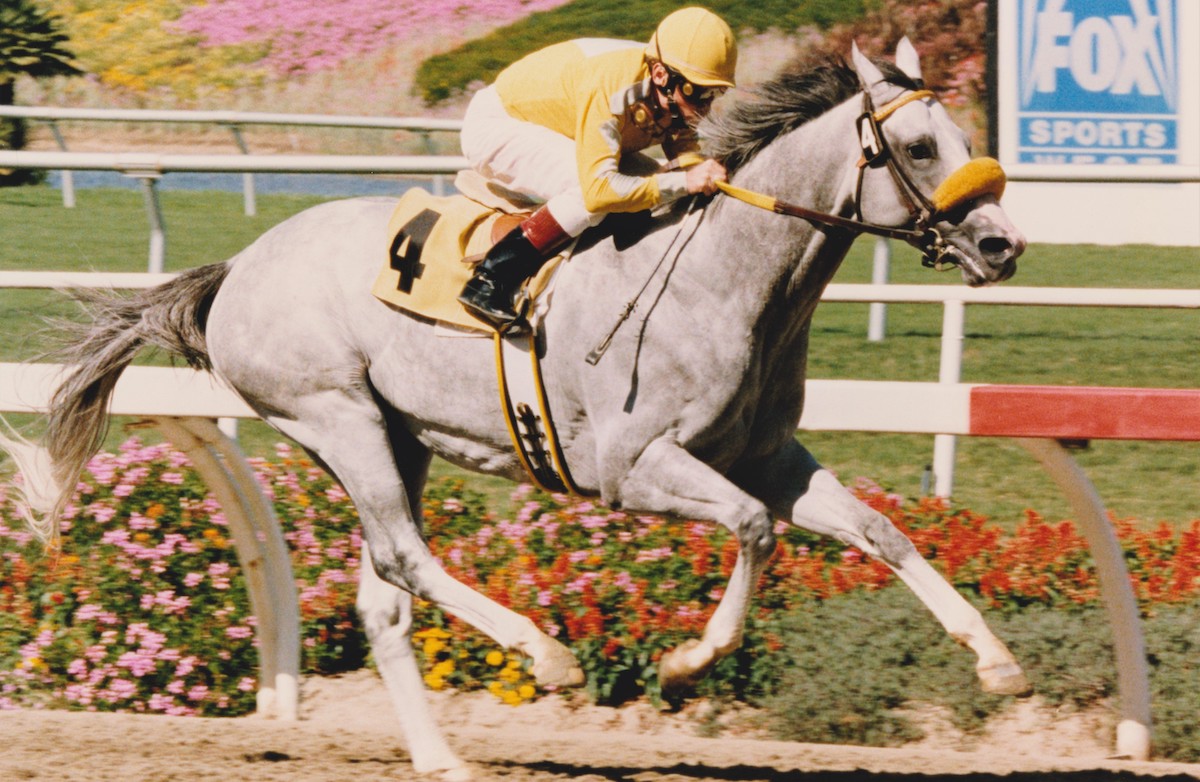 After a few months the radius scanned clean, and Free House went back to work, winning the Bel Air Handicap at Hollywood Park in his first start at four. It was later revealed that Free House had allegedly tested positive for a trace of the bronchodilator Clenbuterol after the race, a charge that Gonzalez, whose record was spotless, vehemently resisted. Toffan fought the case through appeals for nearly two years before the accusation was thrown out.
After a few months the radius scanned clean, and Free House went back to work, winning the Bel Air Handicap at Hollywood Park in his first start at four. It was later revealed that Free House had allegedly tested positive for a trace of the bronchodilator Clenbuterol after the race, a charge that Gonzalez, whose record was spotless, vehemently resisted. Toffan fought the case through appeals for nearly two years before the accusation was thrown out.
“I remember going into the courthouse that last day,” Gonzalez said. “There were a lot of reporters there, and I think they were just waiting for the judge to say ‘guilty.’ It took a long time, but that was important to the memory of Free House.”
Tour de force
The Bel Air primed Free House for his tour de force one month later in the Pacific Classic at Del Mar, in which he defeated not only defending champion Gentlemen, but also Touch Gold, his old pal from the ’97 Triple Crown.
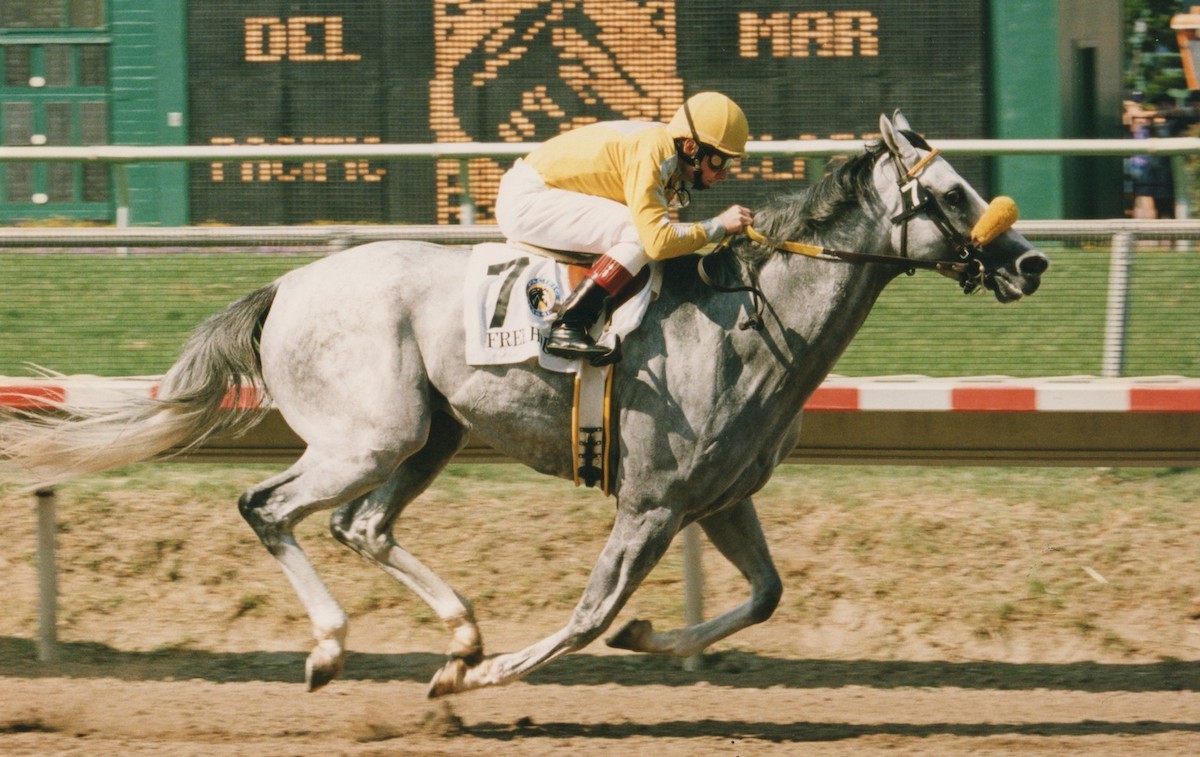 Jim Murray, the Pulitzer Prize-winning sports writer, composed what turned out to be his final syndicated column after watching Free House win the Classic. Murray was taken by a heart attack two days after the race.
Jim Murray, the Pulitzer Prize-winning sports writer, composed what turned out to be his final syndicated column after watching Free House win the Classic. Murray was taken by a heart attack two days after the race.
“Free House won so easily, jockey Chris McCarron should have brought a book,” Murray wrote. “He rode him like the Wilshire bus.”
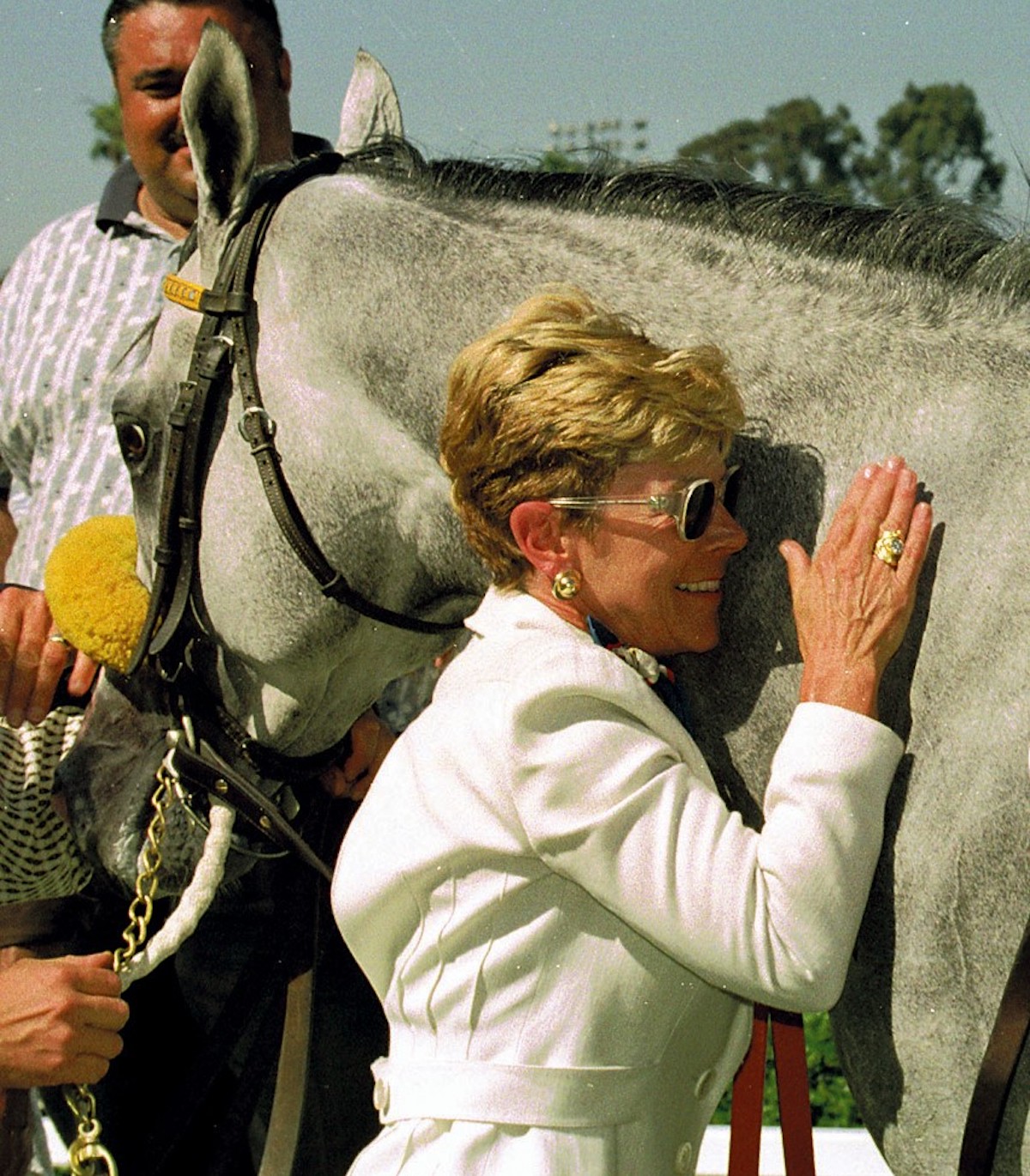 After Del Mar, Free House tried the Woodward Stakes in New York but merely spun his wheels over the sandy Belmont track. Back in California, he ran second to a refreshed Silver Charm in the Goodwood Stakes at Santa Anita, echoing their earlier West Coast confrontations in races like the San Vicente (Silver Charm), San Felipe (Free House) and Santa Anita Derby (Free House).
After Del Mar, Free House tried the Woodward Stakes in New York but merely spun his wheels over the sandy Belmont track. Back in California, he ran second to a refreshed Silver Charm in the Goodwood Stakes at Santa Anita, echoing their earlier West Coast confrontations in races like the San Vicente (Silver Charm), San Felipe (Free House) and Santa Anita Derby (Free House).
After that, Silver Charm headed to the Breeders’ Cup Classic, but Free House did not. His owners quite sensibly balked at the punitive supplementary fee of $800,000 to run, since neither Free House nor Smokester had been nominated to the Breeders’ Cup program.
Gonzalez wasted no time putting Free House back into the game as a five-year-old. The San Antonio Handicap came up on Feb. 7, 1999, in which Free House gave the Mandella runner Malek four pounds and won by a neck. Malek came back to just miss in the Dubai World Cup.
The 1999 Santa Anita Handicap offered the two old rivals a test of their full maturity as Thoroughbred athletes. From the start of the mile and a quarter, Free House and McCarron took the initiative, while Silver Charm and Gary Stevens kept them in sight from the inside.
With a quarter of a mile to run, Stevens angled to the outside for a clear run, while the younger Event Of The Year put serious pressure on the leader. Free House refused to budge, however, and even though Silver Charm came calling with a strong, final push, the day belonged to Freebie and his team.
That was his last hurrah. An ambitious season was cut short when Free House strained a back muscle while finishing second to 1998 Kentucky Derby winner Real Quiet in the Pimlico Special. After 23 starts, 10 wins and nine placings over four seasons, a six-year-old campaign was never in the cards. Free House had earned $3,178,971 and a chance to be a stallion at Vessels Farm in north San Diego County, where he would reign as king of the hill.
The Fantasy Stakes winner House Of Fortune came from the first Free House crop to reach the racetrack, but nothing quite that good followed. Still, he got winners, and his offspring were reliable at their market level.
Free House celebrated turning 10 with a decent book of mares and the further exploits of House Of Fortune, who added the Hollywood Oaks on June 12, 2004, to her earlier score in the Fantasy.
Five weeks later, on the afternoon of Monday, July 19, Free House was getting a bath after spending his usual day in a sun pen when he went up on his hind legs and slipped on the wash mat. He came down with a sickening thud. Trudy McCaffery recalled the terrible moment as relayed by the traumatized handlers.
‘He always liked to play’
“There was nothing out of the ordinary,” said a shattered McCaffery, the day after it happened. “It was just a rout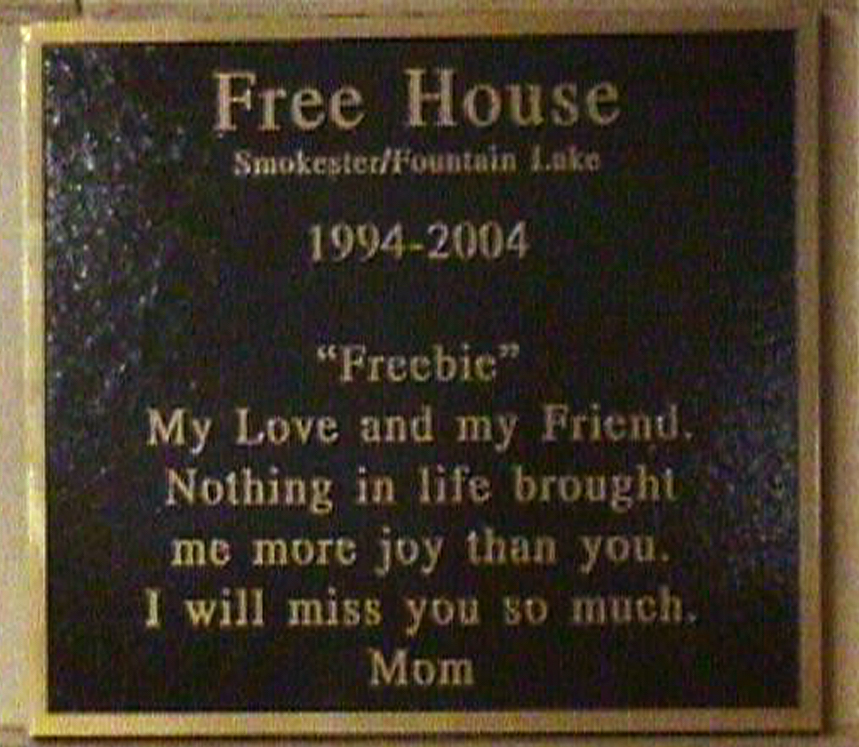 ine bath, something they’d done hundreds of times before. But like they said, ‘This boy, he always liked to play. But he hit his head so hard.’”
ine bath, something they’d done hundreds of times before. But like they said, ‘This boy, he always liked to play. But he hit his head so hard.’”
Free House could not be saved. A pall descended over the valley that extended to the wider reach of his following.
“This is as sad as I have felt over a horse passing since Secretariat died in ’89,” read one email sent to the owners. “I am sure the Lord has a special stall, deep with straw, prepared for one of his finest creations,” read another.
McCaffery died in 2007 after a battle with lung cancer. Toffan passed away in 2019, forever linked with a legacy of his outstanding runners that also included major stakes winners Bien Bien, Came Home, Bienamado, Pacific Squall, and Del Mar Dennis. Gonzalez, now 78, retired from training in 2012 and lives near Santa Anita.
As for Free House, his remains were buried in a grassy swale by a pond at Vessels Farm – now doing business as Ocean Breeze Farm – with a marker and a meditation bench for those who want to spend a time in quiet tribute to a Thoroughbred who left nothing on the track.
“That was him,” Gonzalez said. “He gave you everything he had every time he ran.”
• Read all Jay Hovdey's features in his Favorite Racehorses series
Graham Dench: Epsom Derby – Ten greatest winning performances of the last 50 years
View the latest TRC Global Rankings for horses / jockeys / trainers / sires


